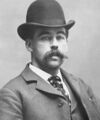Template:Selected anniversaries/May 7: Difference between revisions
No edit summary |
No edit summary |
||
| Line 50: | Line 50: | ||
||1915: World War I: German submarine U-20 sinks RMS ''Lusitania'', killing 1,198 people, including 128 Americans. Public reaction to the sinking turns many formerly pro-Germans in the United States against the German Empire | ||1915: World War I: German submarine U-20 sinks RMS ''Lusitania'', killing 1,198 people, including 128 Americans. Public reaction to the sinking turns many formerly pro-Germans in the United States against the German Empire | ||
||1925: Lauri Vaska born ... chemist and academic. | ||1925: Lauri Vaska born ... chemist and academic. Vaska contributed to the coordination chemistry of transition metals, homogeneous catalysis, and both organometallic and bioinorganic chemistry. Pic search yes: https://www.google.com/search?q=lauri+vaska | ||
||1928: The Jinan incident begins with Japanese forces killing the Chinese negotiating team in Jinan, China, and going on to kill over 2,000 Chinese civilians in the following days. | ||1928: The Jinan incident begins with Japanese forces killing the Chinese negotiating team in Jinan, China, and going on to kill over 2,000 Chinese civilians in the following days. | ||
||1941: James George Frazer dies ... anthropologist and academic. Pic. | |||
||1944: Charles Stuart Ballantine dies ... mathematical physicist and inventor. He discovered the "antenna effect" in coil-type systems and invented the capacity compensator for its control. In 1923 he was awarded the John Tyndall Fellowship in physics at Harvard University. At this time he developed the principle of negative feedback to stabilize and reduce distortion in transmission circuits, modulators, amplifiers, and detectors. Mr. Ballantine engaged in extensive studies of detection at high signal levels, fluctuation noise in radio receivers and tubes, development of technique for sound measurements of loudspeakers and receivers, microphone calibration, and broadcast receiver design. He invented a method of stabilizing radio-frequency amplifiers by means of a Wheatstone-bridge circuit, and in 1929 made important contributions to the design and use of vacuum tubes for radio receiving sets, later improving condenser microphones in such a way as to permit increased fidelity in the transmission of sound programs. One of the most widely known of his many contributions to radio was his invention of the first "throat microphone" to pick up voice sounds directly from the larynx, a device of major importance to aviators, later widely used by the Army Air Force. Pic: https://ethw.org/Charles_Stuart_Ballantine | ||1944: Charles Stuart Ballantine dies ... mathematical physicist and inventor. He discovered the "antenna effect" in coil-type systems and invented the capacity compensator for its control. In 1923 he was awarded the John Tyndall Fellowship in physics at Harvard University. At this time he developed the principle of negative feedback to stabilize and reduce distortion in transmission circuits, modulators, amplifiers, and detectors. Mr. Ballantine engaged in extensive studies of detection at high signal levels, fluctuation noise in radio receivers and tubes, development of technique for sound measurements of loudspeakers and receivers, microphone calibration, and broadcast receiver design. He invented a method of stabilizing radio-frequency amplifiers by means of a Wheatstone-bridge circuit, and in 1929 made important contributions to the design and use of vacuum tubes for radio receiving sets, later improving condenser microphones in such a way as to permit increased fidelity in the transmission of sound programs. One of the most widely known of his many contributions to radio was his invention of the first "throat microphone" to pick up voice sounds directly from the larynx, a device of major importance to aviators, later widely used by the Army Air Force. Pic: https://ethw.org/Charles_Stuart_Ballantine | ||
Revision as of 08:12, 17 May 2019
1794: Chemist, aristocrat, and crime-fighter Antoine Lavoisier publishes his groundbreaking treatise on crimes against chemical constants, introducing nomenclature and terminology used to this day.
1794: French Revolution: Robespierre introduces the Cult of the Supreme Being in the National Convention as the new state religion of the French First Republic.
1832: Mathematician Carl Gottfried Neumann born. He will study physics with his father, and later work as a mathematician, dealing almost exclusively with problems arising from physics.
1860: Electrical engineer and inventor Oliver Blackburn Shallenberger born. He will invent the first successful alternating current electrical meter, which will be critical to the general acceptance of AC power.
1895: Russian physicist Alexander Stepanovich Popov demonstrates to the Russian Physical and Chemical Society his invention, the Popov lightning detector — a primitive radio receiver.
1895: Mathematician and alleged immortal John Havelock purchases signed first edition of The Time Machine, telling author H. G. Wells that the book "is an instant classic."
1895: First publication of The Time Machine by H. G. Wells.
1896: Serial killer H. H. Holmes is executed for the murder of his friend and accomplice Benjamin Pitezel.
1960: Film director and arms dealer Egon Rhodomunde raises funds for new film about the American U-2 pilot Gary Powers.
1960: Cold War: U-2 Crisis of 1960: Soviet leader Nikita Khrushchev announces that his nation is holding American U-2 pilot Gary Powers.
1960: Actor, cryptographer, and alleged time-traveller Niles Cartouchian meets privately with Nikita Khrushchev and Gary Powers in a successful attempt to avoid nuclear war.
2016: Crimson Blossom 2 voted Picture of the Day by the citizens of New Minneapolis, Canada.











